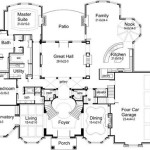How To Find The Floor Plans For My House
Locating the floor plans for a house can be a valuable asset for homeowners. These plans provide detailed information about the layout, dimensions, and structural elements of the property. Whether planning renovations, undertaking repairs, or simply seeking a better understanding of the home's design, access to accurate floor plans can prove indispensable. This article outlines several methods for obtaining these essential documents, offering a comprehensive guide to navigating the process.
Checking Existing Documentation and Records
The first and often most straightforward approach involves reviewing existing documentation associated with the property. Before embarking on an external search, meticulously examine any records already in possession. This can save considerable time and effort. Deeds, mortgages, and previous sale agreements frequently contain relevant information, sometimes including floor plans, particularly if the house is relatively new or has undergone significant alterations in the past. Contractual documents from builders or developers are prime candidates for containing detailed plans.
Title insurance policies may also hold clues. These policies often include surveys and property descriptions, which can provide a basic outline of the house's footprint and layout. While a title insurance policy might not offer a complete, detailed floor plan, it could contain enough information to initiate further investigation or to corroborate findings from other sources. These documents are typically stored in personal filing systems or digitally on computers or external drives. A thorough search of these repositories is essential before exploring external resources.
Consider also any homeowner's insurance documents. These policies sometimes include appraisals or assessments that were based on floor plans. While the insurance documentation itself might not include the complete plan, it might reference its existence or provide details about where it could be located. Furthermore, check for records of any previous renovations or additions. Building permits and contractor agreements from past projects are highly likely to contain floor plans, or at least portions of them relevant to the remodeled areas.
In the absence of readily accessible documents, consider contacting previous owners of the property. If possible, reaching out to former occupants can be remarkably helpful. They may possess floor plans or recall where such documents were stored. Even anecdotal information from previous owners regarding the house's construction or modifications can provide valuable context for the search.
Contacting Local Government and Building Departments
If personal documents do not yield the desired floor plans, the next step involves exploring publicly accessible records. Local government agencies, particularly building departments and planning offices, often maintain archives of building permits and construction documents. These records can be invaluable sources for obtaining floor plans, especially for houses built after the establishment of local building codes.
Contacting the local municipality's building department is a crucial step. Building departments are responsible for overseeing and regulating construction activities within their jurisdiction. As such, they typically require builders and developers to submit detailed plans as part of the permitting process. These plans are usually archived and made available for public inspection, subject to certain restrictions and fees. When contacting the building department, it is essential to have the property address and any relevant information, such as the year of construction or any known permit numbers. This information will assist the department in locating the appropriate records.
Planning offices, which oversee land use and zoning regulations, may also possess relevant information. These offices often maintain records of site plans and development approvals, which can sometimes include floor plans. Even if the planning office does not possess the complete floor plan, it may have documents that provide valuable insights into the property's layout and dimensions.
Accessing these records typically involves submitting a formal request, often accompanied by a fee. The process for obtaining documents varies from municipality to municipality. Some jurisdictions may allow online searches, while others require in-person visits or mailed requests. Be prepared to provide detailed information about the property and to specify the type of documents being sought. Patience is often required, as retrieval of archived records can take time.
It's important to note that access to certain documents may be restricted due to privacy concerns or proprietary information. However, in many cases, the floor plans for a residential property are considered public records, particularly if they were submitted as part of a building permit application. If access is denied, inquire about the specific reasons for the denial and whether alternative documents are available.
Utilizing Online Resources and Professional Services
In situations where physical documents are unavailable or difficult to access, online resources and professional services can offer alternative avenues for obtaining floor plans. The internet provides a wealth of information and tools that can assist in the search, while professional services offer expertise and specialized knowledge to navigate complex situations.
Online databases and search engines can be valuable tools for locating floor plans. Several websites specialize in providing property information, including tax records, property assessments, and historical building permits. While these websites may not always have complete floor plans, they can often provide valuable information about the property's dimensions, layout, and construction history. These details can be used to create a basic floor plan or to supplement information obtained from other sources.
Real estate websites and online property listings can sometimes include floor plans, particularly for newer homes or properties that have been recently renovated. These listings often feature high-quality photographs and virtual tours, which can provide a visual understanding of the house's layout and dimensions. While online listings may not provide precise measurements, they can offer a general overview of the floor plan and the relationship between different rooms.
Consider engaging the services of a professional architect or building designer. These professionals possess the expertise and resources to create accurate floor plans based on existing conditions or historical data. An architect can conduct a detailed survey of the property, measure the dimensions of each room, and create a comprehensive floor plan that accurately reflects the house's layout. This option is particularly useful for older homes where original floor plans are unavailable or incomplete.
Real estate appraisers are another potential resource. They are often required to create floor plans as part of their valuation process. While they might not be able to release the official appraisal document due to privacy regulations, they may be able to provide a copy of the floor plan, or at least offer insights into how the property was measured and assessed. Surveyors can also be hired to create detailed site plans and property surveys, which can include information about the house's footprint and location on the land. These surveys can be used to create a basic floor plan or to supplement information obtained from other sources.
Finally, consider contacting local historical societies or preservation organizations. These groups often maintain archives of historical documents and photographs related to local properties. They may possess floor plans or other information about the house's original construction or subsequent modifications. Even if they do not have the complete floor plan, they may be able to provide valuable insights into the house's history and design.
Ultimately, the successful location of floor plans for a house requires a multifaceted approach. Combining thorough research into existing documents, engagement with local government agencies, and exploration of online resources and professional services offers the best chance of obtaining the desired information. Remember to be patient and persistent throughout the process, as accessing historical records and navigating bureaucratic procedures can take time and effort.

9 Ways To Find Floor Plans Of An Existing House Blueprints Archid

How To Find The Original Floor Plans For Your House

House Plans How To Design Your Home Plan

House Plans How To Design Your Home Plan

House Plans How To Design Your Home Plan

House Plans How To Design Your Home Plan

How To Find Building Plans For My House Architecture Design Plan

How To Read A Floor Plan With Dimensions Houseplans Blog Com

House Plans How To Design Your Home Plan

Where You Can Buy House Plans Live Home 3d
Related Posts








